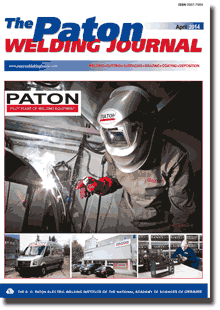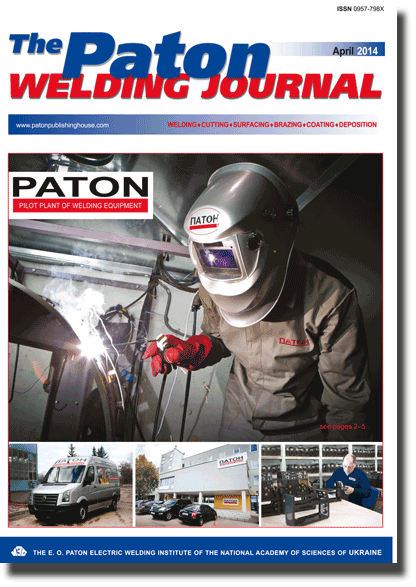| 2014 №04 (08) |
DOI of Article 10.15407/tpwj2014.04.01 |
2014 №04 (02) |

The Paton Welding Journal, 2014, #4, 6-16 pages
STRUCTURAL FEATURES OF FSW JOINTS OF METALS WITH DIFFERENT ELEMENT SOLUBILITY IN THE SOLID PHASE
G.M. GRIGORENKO, L.I. ADEEVA, A.Yu. TUNIK, S.N. STEPANYUK, M.A. POLESHCHUK and E.V. ZELENIN
E.O. Paton Electric Welding Institute, NASU. 11 Bozhenko Str., 03680, Kiev, Ukraine. E-mail: office@paton.kiev.ua
Abstract
Results of investigation of the structure and properties of dissimilar metal joints made by friction stir welding (FSW) are given. Systems with unlimited (Ni-Cu) and limited (Cu-Fe) solubility, as well as absence of component solubility (Al-Fe) in the solid state were studied. FSW of copper and nickel produced a sound welded joint with metal interpenetration to 3 mm depth. Mechanical mixing of metals plays the leading role in this process, whereas diffusion processes are negligible. Structure refinement occurs in mechanical mixing bands as a result of recrystallization processes. Copper diffusion into nickel along grain boundaries proceeds down to 20 mm depth with formation of interlayers of these metals solid solution. When studying the copper to steel welded joint, it was established that metal mixing has a leading role also in this process, and the role of diffusion processes is small. During welding a considerable grain refinement takes place both in the recrystallization zone, and in thermomechanically affected and heat affected zones. FSW of aluminium to iron resulted in formation of the joint zone of a considerable volume with aluminium penetration into iron down to 2.5 mm depth. Metal interaction proceeds here, namely mass transfer, primarily, of aluminum, and subsequent formation of Fe2Al7, FeAl2 compounds. The hardest regions of welded joint zone contain intermetallics in the aluminium matrix. Such a structure has the hardness of 2870 С 410 MPa that is more than 3 times lower than that of iron aluminides Results of the conducted investigations allow recommending this welding process to produce bimetal joints of dissimilar metals with different solubility of elements in the solid state. 20 Ref., 5 Tables, 15 Figures.
Keywords: friction stir welding, welded joint, bimetal mechanical mixing of metals, diffusion, solid phase solubility, microstructure, X-ray microprobe analysis, elemental composition, microhardness
Received: 02.10.13
Published: 28.04.14
References
- Thomas, W.M., Nicholas, E.D., Needam, J.C. et al. Friction stir butt welding. Pat. 9125978.8 GB. Publ. Oct. 1995.
- Vill, V.I. (1970) Friction welding of metals. Leningrad: Mashinostroenie. Lebedev, V.K., Chernenko, I.A., Mikhalsky, R. et al. (1987) Friction welding: Refer. Book. Leningrad: Mashinostroenie.
- Mishraa, R.S., Ma, Z.Y. (2005) Friction stir welding and processing. Mater. Sci. and Eng., 50, 1-78. https://doi.org/10.1016/j.mser.2005.07.001
- Eriksson, L.G., Larsson, R. (2003) Rotation stir welding: Research and new fields of application. Tekhnologiya Mashinostroeniya, 6, 81-84.
- Lyudmirsky, Yu.G., Kotlyshev, R.R. (2010) Friction stir welding of aluminium alloys in building industry. Nauchn. Vestnik VGASU. Stroitelstvo i Arkhitektura, 3, 15-22.
- Nikityuk, Yu.N., Grigorenko, G.M., Zelenin, V.I. et al. (2013) Technology of reconditioning repair of slab moulds of continuous-casting machine by friction stir hardfacing. Sovr. Elektrometallurgiya, 3, 51-55.
- Watanabe, H., Takayama, H., Yanagisawa, A. (2006) Joining of aluminum alloy to steel by friction stir welding. J. Mater. Proc. Technol., 178, 342-349. https://doi.org/10.1016/j.jmatprotec.2006.04.117
- Lee, W.-B., Schmuecker, M., Mercardo, U.A. et al. (2006) Interfacial reaction in steel-aluminum joints made by friction stir welding. Scripta Mater., 55, 355-358. https://doi.org/10.1016/j.scriptamat.2006.04.028
- Kostka, A., Coelho, R.S., dos Santos, J. et al. (2000) Microstructure of friction stir welding of aluminium alloy to magnesium alloy. Ibid., 66, 953-956.
- Kwon, Y.J., Shigematsu, I., Saito, N. (2008) Dissimilar friction stir welding between magnesium and aluminium alloys. Materials Letters, 62, 3827-3829. https://doi.org/10.1016/j.matlet.2008.04.080
- Xue, P., Ni, D.R., Wang, D. et al. (2011) Effect of friction stir welding parameters on the microstructure and mechanical properties of the dissimilar Al-Cu joints. Mater. Sci. and Eng., 528, 4683-4689. https://doi.org/10.1016/j.msea.2011.02.067
- Saeida, T., Abdollah-Zadehb, A., Sazgarib, B. (2010) Weldability and mechanical properties of dissimilar aluminum-copper lap joints made by friction stir welding. J. Alloys and Compounds, 490, 652-655. https://doi.org/10.1016/j.jallcom.2009.10.127
- Grigorenko, G.M., Zelenin, V.I., Kavunenko, P.M. et al. (2012) Stir friction hardfacing by nickel of copper mould walls of continuous-casting machines. In: Problems of resource and service safety of structures, constructions and machines. Kyiv: PWI, 369-372.
- Poleshchuk, M.A., Grygorenko, G.M., Kavunenko, P.M. et al. Insert of working tool of machine for friction stir welding and surfacing. Pat. 25394 for a design, Ukraine. Publ. 10.09.2013.
- Beckert, M.K., Clemm, H. (1988) Methods of metallographic etching: Refer. Book. Moscow: Metallurgiya.
- Hansen, M., Anderko, K. (1962) Structure of binary alloys. Vol.1, 2. Moscow: Metallurgizdat. (1979) Binary and multicomponent systems on copper base: Refer. Book. Ed. by N.Kh. Abrikosov. Moscow: Nauka.
- Rabkin, D.M., Ryabov, V.R., Gurevich, S.M. (1975) Welding of dissimilar metals. Kiev: Tekhnika.
- Ryabov, V.R., Rabkin, D.M., Kurochko, R.S. et al. (1984) Welding of dissimilar metals and alloys. Moscow: Mashinostroenie.
Suggested Citation
G.M. GRIGORENKO, L.I. ADEEVA, A.Yu. TUNIK, S.N. STEPANYUK, M.A. POLESHCHUK and E.V. ZELENIN (2014) STRUCTURAL FEATURES OF FSW JOINTS OF METALS WITH DIFFERENT ELEMENT SOLUBILITY IN THE SOLID PHASE. The Paton Welding J., 04, 6-16.The cost of subscription/purchase order journals or individual articles
| Journal/Currency | Annual Set | 1 issue printed |
1 issue |
one article |
| TPWJ/USD | 384 $ | 32 $ | 26 $ | 13 $ |
| TPWJ/EUR | 348 € | 29 € | 24 € | 12 € |
| TPWJ/UAH | 7200 UAH | 600 UAH | 600 UAH | 280 UAH |
| AS/UAH | 1800 UAH | 300 UAH | 300 UAH | 150 UAH |
| AS/USD | 192 $ | 32 $ | 26 $ | 13 $ |
| AS/EUR | 180 € | 30 € | 25 € | 12 € |
| SEM/UAH | 1200 UAH | 300 UAH | 300 UAH | 150 UAH |
| SEM/USD | 128 $ | 32 $ | 26 $ | 13 $ |
| SEM/EUR | 120 € | 30 € | 25 € | 12 € |
| TDNK/UAH | 1200 UAH | 300 UAH | 300 UAH | 150 UAH |
| TDNK/USD | 128 $ | 32 $ | 26 $ | 13 $ |
| TDNK/EUR | 120 € | 30 € | 25 € | 15 € |
AS = «Automatic Welding» - 6 issues per year;
TPWJ = «PATON WELDING JOURNAL» - 12 issues per year;
SEM = «Electrometallurgy Today» - 4 issues per year;
TDNK = «Technical Diagnostics and Non-Destructive Testing» - 4 issues per year.


